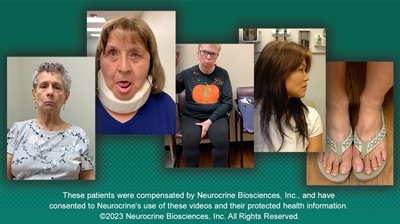This is a hypothetical patient case developed for educational purposes by Tammy J. LeBlanc-Russo, NP-P, based on characteristics of patients with tardive dyskinesia as seen in clinical practice. The hypothetical case was sponsored and co-developed by Neurocrine Biosciences.
Clare M. is a 52-year-old woman being treated for major depressive disorder (MDD). At a recent medication management visit, she expressed frustration to her nurse practitioner (NP) that people have been pointing out the sucking noises she makes that she cannot seem to control.
Clare was being seen by her NP for a routine medication management visit when she expressed frustration with lip puckering movements and sucking sounds that she can’t seem to control. Sometimes she notices the movements and sounds, but usually isn’t bothered by it until someone points it out and asks her to stop. She states this is starting to impact her relationships, noting that her sister has stopped sitting near her and her husband is always teasing that she is “sucking on imaginary candy.” She wonders if the movements are related to treatment of her MDD.
Patient Information
- Name: Clare M.
- Age: 52 y
- Sex: Female
- Race/Ethnicity: White
- BMI: 31
- BP: 152/108 mm Hg
- Current problems:
- MDD
- Hypoparathyroidism
- Migraine headaches
- Current medications:
- Aripiprazole 15 mg PO QHS
- Escitalopram 20 mg PO QD
- Ergocalciferol 50,000 units weekly
- Magnesium oxide 500 mg PO BID
- Topamax 100 mg PO QD
BID, twice daily; BMI, body mass index; BP, blood pressure; PO, by mouth; QD, every day; QHS, every night at bedtime.
Clare was diagnosed with MDD in her mid-20s and has been treated with antidepressants and atypical antipsychotics for 27 years. She has been taking aripiprazole for 5 years and her depression is currently in partial remission. Based on her history, the goals of the case are to maintain control of her depression and address the abnormal movements and sounds.
Psychiatric History
- Current diagnosis: MDD
- Previous psychiatric diagnoses: None reported
- Current psychiatric medication: Aripiprazole 15 mg and escitalopram 20 mg
- Psychiatric medication history: Previously on fluoxetine
- Safety concerns: None reported
- Previous psychiatric hospitalizations: None
- Substance use: None reported
Clare tells her NP that she has been experiencing the movement and sound symptoms for the past 6 months. The NP verified that there was no gum or candy in her mouth and verified that her teeth were not bothering her. She then conducted an exam using the AIMS scale, which revealed a total score of 3. The NP also noted an absence of muscle rigidity and that gait was normal with normal arm swing. There was no evidence of parkinsonian tremor. A diagnosis of TD with mild severity was made.
Motor Evaluation
- Abnormal facial and oral movements
- Lip puckering, sucking with sounds
- No muscle rigidity noted
- Normal gait with normal arm swing
- No tremor observed
- AIMS exam:
AIMS, Abnormal Involuntary Movement Scale.
Clare’s NP provided her with education about TD and discussed treatment with VMAT2 inhibitors. Although Clare’s TD symptoms are mild, current practice guidelines support consideration of treatment with a VMAT2 inhibitor given the impact of the symptoms on Clare’s social and emotional well-being.1 Clare indicated that she would like to try the VMAT2 inhibitor. The NP provided Clare with a visit summary that included information on her symptoms and diagnosis, her treatment plan, and what to expect at follow-up visits.
Notes From Today's Visit
- Provided patient education on TD
- Discussed use of VMAT2 inhibitors to treat abnormal movements associated with TD
- Reviewed the treatment plan and discussed what to expect at the next visit
VMAT2, vesicular monoamine transporter type 2.
Reference
1. American Psychiatric Association. The American Psychiatric Association Practice Guideline for the Treatment of Patients With Schizophrenia. 3rd ed. American Psychiatric Association; 2021.
©2022 Neurocrine Biosciences, Inc. All Rights Reserved.
MED-MSL-TD-US-0218 v2 CP-TD-US-0671 v3 10/2022

